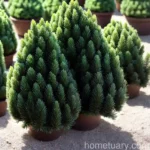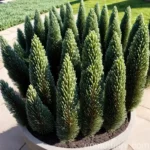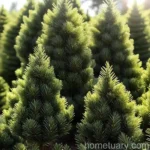Norway Spruce (Picea abies ‘Hillside Upright’)
Norway spruce (Picea abies) is a majestic and popular evergreen conifer known for its great size, graceful habit, and suitability for landscaping. Its cultivar ‘Hillside Upright’ is a particular variety that displays unique features and characteristics.
In this comprehensive guide, we will delve into the world of Norway spruce, focusing on the ‘Hillside Upright’ cultivar. We will cover its culture, uses, care requirements, diseases, pests, and more. By the end of this article, you will have a thorough understanding of how to best care for and utilize the Norway spruce (Picea abies ‘Hillside Upright’) in your landscape.
What is Plant: Norway Spruce (Picea abies ‘Hillside Upright’)?
Norway spruce (Picea abies) is a species of spruce native to Northern, Central, and Eastern Europe. It is a large, fast-growing evergreen tree that can reach impressive heights of up to 60 meters (197 feet) under the right conditions.
The ‘Hillside Upright’ cultivar of Norway spruce is known for its narrow, upright form, making it an excellent choice for landscapes with limited space. Its dense branching, attractive foliage, and adaptability to various soil types further contribute to its popularity among landscapers and homeowners.

Norway spruce (Picea abies) holds great significance in forestry, landscaping, and horticulture due to its versatile nature and aesthetic appeal. Its ‘Hillside Upright’ variety, in particular, is valued for its unique growth habits and ornamental characteristics.
Now, let’s delve into the key takeaways for understanding and caring for the Norway spruce (Picea abies ‘Hillside Upright’).
Key Takeaways – Norway Spruce (Picea abies ‘Hillside Upright’)
Culture
The culture of Norway spruce (Picea abies ‘Hillside Upright’) refers to its preferred environmental conditions, growth habits, and overall management. Understanding its cultural needs is essential for ensuring its health and vitality in a landscape setting.
- Hardiness: ‘Hillside Upright’ spruce is hardy in USDA zones 3-7.
- Growth Habit: Upright and narrow form, suitable for smaller spaces.
- Soil Preference: Well-draining, loamy soil with a slightly acidic pH.
- Watering: Regular watering, especially during its establishment phase.
- Sunlight: Full sun to partial shade, with at least 6 hours of direct sunlight.
- Pruning: Minimal pruning required to maintain its natural shape.
- Fertilization: Moderate feeding in early spring using a balanced fertilizer.
Uses
Understanding the uses of Norway spruce (Picea abies ‘Hillside Upright’) is crucial for incorporating it effectively in landscape design and maximizing its benefits.
- Landscape Specimen: Ideal for creating vertical interest in gardens and landscapes.
- Privacy Screen: Forms a dense barrier when planted in rows.
- Windbreak: Provides excellent wind protection due to its dense foliage.
- Winter Interest: Adds visual appeal to winter landscapes with its evergreen foliage.
- Wildlife Habitat: Offers nesting sites for birds and shelter for small animals.
Water
Proper watering is essential for the health and growth of Norway spruce (Picea abies ‘Hillside Upright’). Understanding its water requirements is crucial for preventing drought stress or waterlogging.
- Watering Frequency: Requires regular watering, especially during dry periods.
- Establishment Phase: Keep the soil consistently moist for the first year after planting.
- Deep Watering: Water deeply, allowing the soil to dry slightly between waterings.
- Mulching: Apply a layer of organic mulch around the base to conserve moisture.
- Avoid Overwatering: Ensure proper drainage to prevent waterlogged conditions.
Sunlight
Sunlight is a crucial factor that directly impacts the growth, development, and overall health of Norway spruce (Picea abies ‘Hillside Upright’).
- Full Sun: Thrives in full sun to partial shade conditions.
- Minimum Sunlight: Requires at least 6 hours of direct sunlight per day.
- Shade Tolerance: Can tolerate some shade but performs best in full sun.
- Eastern Exposure: Ideal for morning sun and afternoon shade in hot climates.
Fertilizer
Applying the right type and amount of fertilizer is essential for promoting healthy growth and vigor in Norway spruce (Picea abies ‘Hillside Upright’).
- Balanced Fertilizer: Apply a slow-release, balanced fertilizer in early spring.
- Nitrogen Needs: Moderate nitrogen requirements for consistent growth.
- Avoid Excess Nitrogen: Over-fertilization can lead to excessive foliage at the expense of roots.
- Foliar Feeding: Consider foliar applications for addressing nutrient deficiencies.
Soil
The soil requirements of Norway spruce (Picea abies ‘Hillside Upright’) play a critical role in its overall health and performance.
- Well-Draining Soil: Thrives in well-draining, loamy soil.
- Soil pH: Prefers slightly acidic soil with a pH range of 5.5 to 6.5.
- Soil Amendments: Incorporate organic matter to improve soil structure and fertility.
Now that we have covered the key takeaways, let’s explore the specific care and maintenance aspects of Norway spruce (Picea abies ‘Hillside Upright’) in more detail.
Pruning
Pruning is an essential aspect of maintaining the shape, health, and overall appearance of Norway spruce (Picea abies ‘Hillside Upright’).
- Timing: Prune in late winter to early spring before new growth emerges.
- Minimal Pruning: Only remove dead, damaged, or diseased branches as needed.
- Thinning: Selectively remove overcrowded branches to improve air circulation.
- Avoid Drastic Pruning: Refrain from severe pruning unless necessary for shaping or restoration.
Propagation
Knowing the methods of propagating Norway spruce (Picea abies ‘Hillside Upright’) is valuable for gardeners and horticulturists looking to expand their stock of this desirable conifer.
- Seed Propagation: Collect and sow fresh seeds in a well-prepared seedbed.
- Cuttings: Root semi-hardwood cuttings in a well-draining medium with bottom heat.
- Grafting: Utilize grafting techniques to propagate specific cultivars or clones.
Container Popularity
Container gardening offers a versatile and convenient option for growing Norway spruce (Picea abies ‘Hillside Upright’), especially in urban or confined settings.
- Urban Landscapes: Adds vertical interest and evergreen beauty to city landscapes.
- Patio Gardens: Suitable for creating a striking focal point in container gardens.
- Versatility: Adaptable to various container sizes and types, provided adequate drainage.
Container Common Diseases
While container gardening offers numerous benefits, it is essential to be mindful of potential diseases that can affect Norway spruce (Picea abies ‘Hillside Upright’) in containers.
- Root Rot: Caused by waterlogged conditions or poorly draining potting mix.
- Fungal Diseases: Damp conditions can promote the development of fungal pathogens.
- Pest Infestations: Container plants may be more susceptible to certain pests.
Disease Diagnosis
Detecting and diagnosing diseases is crucial for implementing effective management strategies and preserving the health of Norway spruce (Picea abies ‘Hillside Upright’).
- Visual Symptoms: Look for changes in foliage color, wilted branches, or abnormal growth.
- Laboratory Analysis: Submit samples to diagnostic labs for accurate disease identification.
- Professional Consultation: Seek advice from certified arborists or plant pathologists for complex cases.
Common Pests
Pests can pose a threat to the well-being of Norway spruce (Picea abies ‘Hillside Upright’) and should be monitored regularly.
- Aphids: Common pests that can cause distortion of new growth.
- Spider Mites: Tiny pests that can cause stippling on the needles.
- Spruce Gall Adelgid: Feeding by these insects can lead to abnormal growths on spruce branches.
Botanist’s Tips
For successful cultivation and management of Norway spruce (Picea abies ‘Hillside Upright’), consider the following expert tips:
- Mulching: Apply organic mulch to conserve moisture and moderate soil temperatures.
- Adequate Spacing: Plant ‘Hillside Upright’ spruce with sufficient spacing to accommodate its mature size.
- Regular Inspection: Monitor for pests, diseases, and cultural issues to address them promptly.
- Seasonal Care: Adjust maintenance practices based on seasonal changes and needs.
Fun Facts
Here are some fascinating and lesser-known tidbits about Norway spruce (Picea abies ‘Hillside Upright’):
- Symbolism: In some cultures, Norway spruce symbolizes longevity, strength, and resilience.
- Herbal Uses: The young shoots and tips of Norway spruce have been historically used for making teas and herbal remedies.
- Historical Significance: Norway spruce is one of the traditional choices for Christmas trees and has been widely used in holiday decorations for centuries.
Now, let’s explore additional resources and external links for further information on Norway spruce (Picea abies ‘Hillside Upright’).
Links to External Resources
- Norway Spruce: A Comprehensive Guide
- Picea abies ‘Hillside Upright’ Cultivar Information
- Growing Conifers in Containers
- Common Diseases of Spruce Trees
- Integrated Pest Management for Conifers
- Landscaping with Evergreen Trees
In conclusion, Norway spruce (Picea abies ‘Hillside Upright’) is a remarkable and versatile conifer that offers a myriad of benefits for landscapes, gardens, and urban settings. By understanding its culture, maintenance requirements, uses, and potential challenges, you can confidently incorporate and care for this exceptional tree in your outdoor spaces.
Remember to consult local horticultural resources and professionals for region-specific guidelines and recommendations when working with Norway spruce (Picea abies ‘Hillside Upright’). Whether used as a standalone specimen, a screen, or a feature in a container garden, the ‘Hillside Upright’ spruce is sure to captivate with its elegant form and enduring evergreen beauty.
Happy gardening!
Keywords: Norway spruce care, Picea abies ‘Hillside Upright’, Norway spruce tree, Picea abies cultivars, Hillside Upright spruce, Norway spruce varieties, Picea abies growth habits, Hillside Upright spruce care tips, Norway spruce planting guide, Norway spruce landscape uses, Picea abies maintenance, Hillside Upright spruce characteristics, Norway spruce diseases, Picea abies ‘Hillside Upright’ pruning techniques, Norway spruce pests, Hillside Upright spruce landscaping ideas, Picea abies ‘Hillside Upright’ growth rate, Norway spruce benefits, Hillside Upright spruce soil requirements, Picea abies propagation methods, Norway spruce winter care, Hillside Upright spruce water requirements, Picea abies ‘Hillside Upright’ sunlight needs, Norway spruce companion plants, Hillside Upright spruce landscape design, Picea abies ‘Hillside Upright’ size, Norway spruce pruning tips, Hillside Upright spruce drought tolerance, Picea abies ‘Hillside Upright’ planting location, Norway spruce site preparation, Hillside Upright spruce fertilizer needs, Picea abies ‘Hillside Upright’ disease resistance, Norway spruce autumn color, Hillside Upright spruce features, Picea abies ‘Hillside Upright’ maintenance requirements, Norway spruce wildlife benefits, Hillside Upright spruce cold hardiness, Picea abies ‘Hillside Upright’ water conservation, Norway spruce seasonal changes, Hillside Upright spruce shade tolerance, Picea abies ‘Hillside Upright’ ornamental value, Norway spruce wind resistance, Hillside Upright spruce soil pH requirements, Picea abies ‘Hillside Upright’ root system, Norway spruce evergreen qualities, Hillside Upright spruce bird nesting habitat, Picea abies ‘Hillside Upright’ unique features, Norway spruce deer resistance, Hillside Upright spruce bark characteristics, Picea abies ‘Hillside Upright’ winter interest















